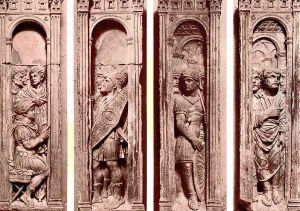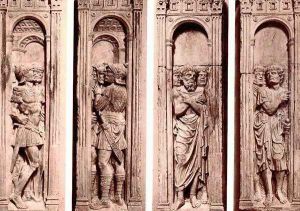Paolo Romano Paintings
Paolo Romano was an Italian sculptor active during the early Renaissance period, whose work is known for its graceful elegance and attention to detail, typical of the era's artistic revival of classical themes and techniques. Born around 1415, his life and career were primarily anchored in Rome, where he contributed significantly to the artistic landscape of the city, which was undergoing a transformation under the influence of the Renaissance. Although specific details about his early life and training are scarce, it is evident from his work that he was deeply influenced by the classical past of Rome and the contemporary humanist trends that sought to revive and reinterpret ancient art and philosophy for the modern age.
Paolo Romano's oeuvre includes sculptures in bronze and marble, and he is particularly noted for his skill in creating delicate, lifelike figures that seem imbued with a sense of motion and emotion. One of his most famous works is the statue of St. Paul, originally created for the Ponte Sant'Angelo in Rome, which showcases his mastery in capturing the dignity and serene strength of the apostle. This statue, like many of his works, reflects the Renaissance interest in individualism and the careful study of the human form.
Despite the limited documentation on his life, Paolo Romano's contributions to Renaissance art have been recognized by his contemporaries and later generations. He was mentioned by the Renaissance biographer Giorgio Vasari, which indicates his significance in the art world of his time. His style, characterized by a blend of naturalism and idealization, helped lay the groundwork for the developments in sculpture that would flourish in Italy and beyond during the later Renaissance.
Paolo Romano's death is presumed to have occurred around 1470. Although he may not be as widely recognized as some of his contemporaries, his work remains an important part of the Renaissance's artistic legacy, illustrating the period's dedication to reviving and elevating the art and culture of classical antiquity. His sculptures continue to be studied and admired for their beauty and for the insight they provide into the artistic and cultural ambitions of Renaissance Rome.

